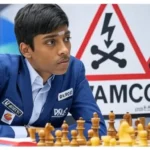If you’ve ever wondered why some of America’s top chess players spend their weekends traveling to small towns and regional tournaments, there’s one big reason: USCF Grand Prix points.
The United States Chess Federation (US Chess) Grand Prix is like a year-long chess marathon. Instead of one single big event, it’s made up of hundreds of tournaments across the country. At each qualifying event, players can earn Grand Prix points. And at the end of the year, the players with the most points win cash prizes and bragging rights.
It’s a competition within the competition. You’re not just playing to win the tournament in front of you. You’re also racing against other players across the nation for points that add up all year long.
How Do Tournaments Qualify for the Grand Prix?
Not every tournament can give out Grand Prix points. To be part of the GP (Grand Prix) circuit, an event must:
- Be US Chess-rated (regular or quick time control).
- Allow all players rated 2200+ to play in the top section, though special events for seniors, juniors, women, or college students can still qualify.
- Have at least $300 in guaranteed prizes for which masters are eligible.
- Guarantee at least $150 for first place.
- Only one prize under $100 can count toward the GP total.
- Keep extra fees (beyond entry fees and US Chess dues) under $25.
- Be listed in the Tournament Life section of Chess Life magazine and clearly marked as a GP event.
- Award points only to current US Chess members. (Foreign GMs, IMs, WGMs, and WIMs can play without joining, but won’t earn points unless they do.)
Some tournaments go the extra mile and sign up as Enhanced Grand Prix events. In these, the GP points you earn are bumped up by one full level.
How Do Players Earn Grand Prix Points?
This is where it gets exciting. The bigger the tournament’s prize fund, the more GP points are available. Winning a strong, well-funded tournament will get you far more points than winning a small local one.
Think of it like Formula 1: different races (tournaments) give different amounts of points depending on their “tier.” A win in a major open with a huge prize fund can rocket you up the leaderboard.
At the end of the year, the top finishers get prize money. In 2024, the payout looked like this:
- 1st Place: $5,000 (GM Jianchao Zhou)
- 2nd Place: $2,500 (GM Fidel Corrales Jimenez)
- 3rd Place: $1,000 (GM Awonder Liang)
- And so on, down to 10th place.
How Many Points Do You Get?
The exact number of Grand Prix points you can win depends on the size of the tournament’s guaranteed prize fund. For example, if the total prizes for which masters are eligible fall between $300 and $499, the winner gets 6 points. The bigger the prize fund, the more points are up for grabs. A $10,000–$29,999 event awards 48 points to the winner, while a massive $30,000+ event gives 36 points for first place, but many more overall because points go deeper down the standings.
There’s even an Enhanced GP option, where all points are boosted, meaning the winner of a $30,000+ Enhanced event can score a whopping 54 points. Points are also shared equally (to two decimal places) if players tie for a place.
| Guaranteed Top Prizes | 1st | 2nd | 3rd | 4th | 5th | 6th | 7th | 8th | 9th | 10th | Total |
|---|---|---|---|---|---|---|---|---|---|---|---|
| $300–$499 | 6 | – | – | – | – | – | – | – | – | – | 6 |
| $500–$749 | 8 | 2 | – | – | – | – | – | – | – | – | 10 |
| $750–$999 | 10 | 5 | – | – | – | – | – | – | – | – | 15 |
| $1,000–$1,499 | 12 | 8 | – | – | – | – | – | – | – | – | 20 |
| $1,500–$1,999 | 14 | 10 | 6 | – | – | – | – | – | – | – | 30 |
| $2,000–$2,499 | 16 | 12 | 8 | 4 | – | – | – | – | – | – | 40 |
| $2,500–$2,999 | 18 | 14 | 10 | 6 | 2 | – | – | – | – | – | 50 |
| $3,000–$3,999 | 20 | 16 | 12 | 8 | 4 | – | – | – | – | – | 60 |
| $4,000–$4,999 | 22 | 18 | 15 | 12 | 8 | 5 | – | – | – | – | 80 |
| $5,000–$5,999 | 24 | 20 | 17 | 14 | 11 | 8 | 6 | – | – | – | 100 |
| $6,000–$9,999 | 26 | 22 | 19 | 16 | 13 | 10 | 8 | 6 | – | – | 120 |
| $10,000–$29,999 | 30 | 26 | 23 | 20 | 16 | 13 | 10 | 8 | 4 | – | 160 |
| $30,000 & up | 36 | 32 | 29 | 26 | 21 | 18 | 14 | 12 | 8 | 4 | 180 |
| $ (Enhanced) | 54 | 48 | 44 | 39 | 31 | 27 | 21 | 18 | 12 | 6 | 300 |
Note: Points are divided equally among tied players, rounded to two decimal places.
Why Do Grandmasters Love the GP?
For many top players, the GP makes smaller tournaments worth the trip. A grandmaster might skip a modest local event, but if it’s a Grand Prix event, those points can help them chase the year-end cash prizes.
Back in the 1980s, when the Grand Prix was first sponsored by Church’s Chicken, players even called them “chicken points”, and the GP circuit was nicknamed the “Chicken Circuit.” The name stuck, even after sponsors changed to Novag (chess computers) and later ChessCafe.
Legendary players like GM Igor Ivanov and GM Aleksander Wojtkiewicz dominated the GP in their eras, traveling constantly to gather points.
The Current Race (2025)
As of August 11, 2025, the GP standings show a familiar leader:
- GM Jianchao Zhou – 487.608 points (already far ahead)
- GM Awonder Liang – 97.389
- GM Fidel Corrales Jimenez – 96.75
- Thomas Fang – 96.5
- GM Semen Khanin – 88
Zhou is not just leading, as he’s running away with it, just like in 2024 when he finished with nearly double the points of second place.
The Junior Grand Prix: A Separate Race for the Next Generation
At the end of the regular GP explanation, it’s worth noting there’s also a Junior Grand Prix (JGP), designed for players under 21. This one isn’t about traveling the country to grab big money, it’s about rewarding young players for facing stronger opponents in slow (long time control) games.
In the JGP:
- You get more points for beating higher-rated players.
- A win against someone 150 points above you is worth 300 points.
- A draw against the same player is worth 150 points.
- There’s a cap of 700 points for a win and 350 for a draw.
It’s all about encouraging young talents to challenge themselves, not just rack up easy wins.
Why the GP Matters
For top professionals, the Grand Prix keeps the competitive fire burning all year. It encourages GMs to show up at events they might otherwise skip, which means stronger competition for everyone.
For chess fans, it’s a fun way to follow the game across the country, every weekend, somewhere in America, a player is chasing Grand Prix points that could decide the year-end standings.
So next time you see a big open tournament in your area, check if it’s a GP event. If it is, you might just spot a grandmaster, not only playing for the tournament trophy, but for those precious Grand Prix points.
I’m the senior editor of Attacking Chess, a keen chess player, rated above 2300 in chess.com. You can challenge me or asking questions at Chess.com.






